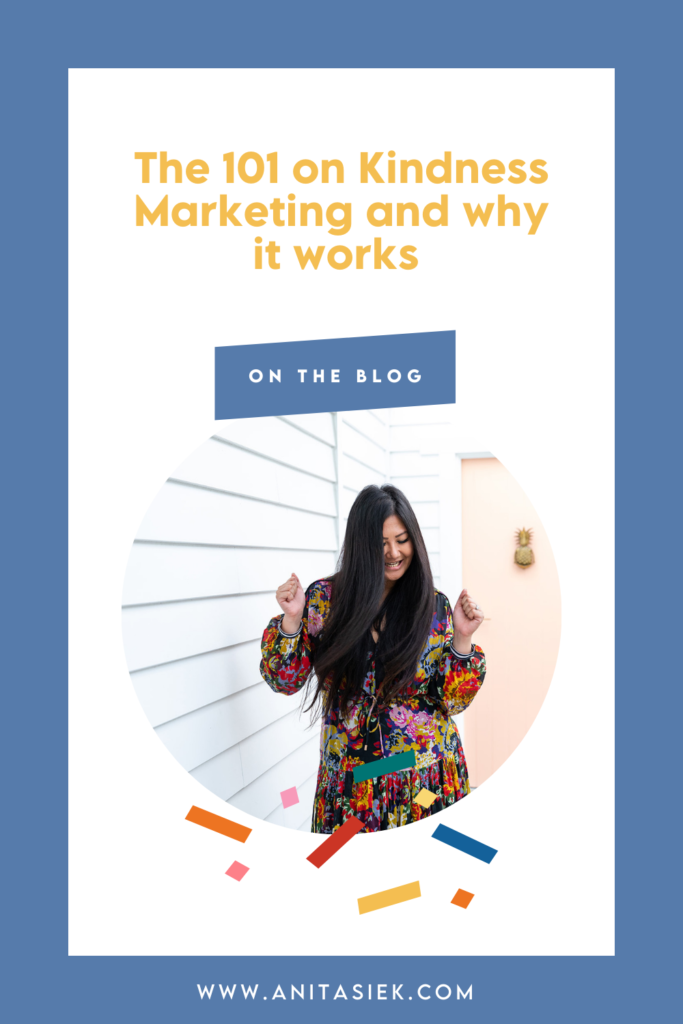The Anita Siek Blog
The Brandfetti Podcast
The Wordfetti
Shop
Podcast
Personal
Content Magic
Business
Lawyer (yep-a-dee-yep, I used to write things people never read) turned Brand and Copy Strategist, and Word-ucator for brands like you, who want to ZIG when others zag.
Hi, I'm Anita!
What is Kindness Marketing and Why it Works

Photo Credit: @mattcrump
Being a good human is a core brand value here for me, and us at Wordfetti.
From the staff we have in the team, to the wonderful humans we have the honour to work with, and to the like-minded community we have created over the last 3-4 years. It’s about Being the stranger that smiles. Moving through life and business with kindness. Coming from a space to serve instead of sell.
I’m talking about sprinkling a little confetti into every interaction I, and the team, have with our clients, community, and friends (inside and outside work hours).
Because here’s the thing, being nice, and being a good human, has a direct impact on the success of your business.
So much so, that we’ve invented a brand new term: kindness marketing.
Kindness marketing is about putting the tactics aside, and focusing on marketing through empathy.
Because after all?
We know that connection is one of humanity’s most basic human needs and we know it drives us. We know it’s what we’re all looking for.
So why not tap into that power?
So without further ado, let’s dive into 3 science-backed ways that kindness marketing will supercharge your biz.

Emotions? They’re contagious things
Vanessa Van Edwards, author and behavioural investigator with Science of People, conducted a study to test the correlation between microexpressions and likeability. In the study, participants sat in the lab and listened to two recordings of the same person say ‘hello’ in different tones. The first, was a low, “hello”, the second, was an upbeat, enthusiastic “hello”.
Check out this video to see what I mean.
Can you guess which one the participants rated more likeable? Yep-a-dee-yep. It’s pretty obvious.
This is the double-pronged beauty of happiness. One: It’s a contagious beast, and people that listen to you or engage with you can easily ‘catch’ the happy from you. And two: Allowing your positivity to shine through actually makes you more likeable.
Let’s illustrate this with an example: There’s two bakeries that make the exact same pastries in town (right down to the exact same buttercream frosting). It’s Sunday morning and you’re dreaming of an almond croissant. Who are you going to visit to get your fix? The bakery where the staff act happy to see you? Or the bakery where the staff seem a bit inconvenienced of your arrival? Yep – you’ll go to the one with the friendly staff.
So, how can you convey ‘happy’ when you aren’t speaking into the phone or there in-person? Great question!
Look at the words you use.
Let’s say you’re writing a contact page.
Instead of saying, ‘if you have any questions, reach out to us’.
You could say, ‘Whether your question is big, small, or somewhere in between, get in touch with us, we’d love to help out.
The difference? Is small. The impact? Is huge. A little warmth? It goes a long way.
And that? Brings us to our second benefit of building kindness into your marketing strategy.

The Science of Reciprocity
As humans, we have the need to reciprocate hardwired into our DNA. When we receive a gift, the parts of our brain associated with emotion (amygdala) and decision-making (prefrontal cortex) are ignited. This triggers a response that makes us want to return the favour.
You know when you’re invited to a coworker’s birthday party, and then you feel the need to invite them to your birthday party? This is a textbook example of reciprocity in action.
“That’s great Anita, but what does it mean for me and my brand?”
Here’s the thing, science tells us that by giving to our audience, they are more likely to give back to us. In biz, this can mean coming on board as a client, adding on to that retainer, or buying our latest, hot-off-the-press resource.
So what and how should you give to your audience?
If your audience are primary school teachers, you could give them a super handy collection of resources to use in the classroom with their little ones.
Two key things to remember with this:
- Make sure you’re giving your audience something of value. Something that they can’t just find through Google.
- Dig deep into your audience to understand what type of freebie is going to actually be helpful for them. Let’s say you’re an eco-friendly clothing designer. Your audience probably isn’t going to have a lot of use for one of your garment patterns (even if it is on the easy-to-do end of the spectrum). What might interest them instead? Perhaps a checklist for an eco-friendly home, printable recipes for natural cleaning products, or a 2-week waste-free living challenge.
But let be be clear, giving doesn’t just mean freebies, bonuses and those little extras.
Being generous with your time and energy will have a much greater impact than a once-off freebie.
What do I mean, exactly?
I mean MAKING time for engagement on whichever social media channels your brand uses. Refusing to post and ghost. And instead? Setting aside blocks of time to get back to your audience with thoughtful, considered responses.
Every day, I dedicate around 1.5-2 hours purely to engaging with the followers of Wordfetti and my personal accounts. If someone spoke to you in-person, you wouldn’t just stare back at them and not reply, would you? No, you’d respond.
And here’s something to remember, as we move deeper and deeper into the digital world, online engagement can’t slip to the wayside. It’s more important than ever.
Take Wordfetti for example, we just about built our whole brand out of instagram.
And fam, there is no way we could have done that had we been posting and ghosting.
It just wouldn’t have happened.
Our followers? They know that when they engage with us, they’ll always get a response. And that? Makes them more inclined to keep the conversation going.
And now? We’re onto our third and final way that good-humanness is the most powerful marketing tool you can keep in your biz toolbox.

Being kind, and valuing kindness, attracts the clients who do the same
For those of us in service-based industries, who work closely with our clients, we’ve proooobably got a pretty clear idea of the types of clients we want to work with. And the types of clients we don’t want to work with.
According to a study by Wellesley College in Massachusetts, we are attracted to people who share a similarity in personality type and values with us.
So, how does this help you with finding the right clients?
By being authentically yourself and strategically conveying your values, beliefs, and approach with your audience, you are sending out a message that says: “This is who I am”. Naturally, those who are similar to you, whose values align with yours, will gravitate toward you.
For this? We are our own best case study. Right from the very start of Wordfetti’s journey, I made good human-ness one of my key values. And the clients who engage us? Are all brilliant, incredible, amazing, good human beings.
So, how do you get clear on who you are?
Develop your values, and go deep.
Let’s say you’re a life coach, and ‘intention’ is one of your values.
To your brand, the value of ‘intention’ may mean:
That you believe in the power of presence. You take the time to show your clients that when you’re with them, your mind isn’t being pulled in any other direction. You choose to be fully present. And intentional with your energy.
And to your brand, the value of ‘intention’ may not mean:
Being too harsh on yourself, or never allowing yourself to take some ‘you’ time to relax, unwind, and zone out.
Knowing the nitty gritty of who you are, and what you stand for? It echoes through what your brand says, and how it says it. The result? More clients that just get it and get you.
And there you have it, fam! 3 science-backed ways that weaving kindness into your words, content, and marketing, will set you up for big biz wins.
To finish off with a final tip-tip-tiparoo:
Humans are a clever bunch, and we can sniff fake, performative or insincere kindness out from a mile away and research suggests that if there’s one thing we dislike more than meanies, it’s meanies who pretend to be nicies. Keep it genuine!
Want to get more copy, brand and content tips? Listen in on Brandfetti and follow me here and the team here.

Check out these popular posts


